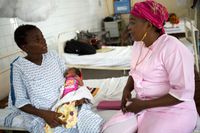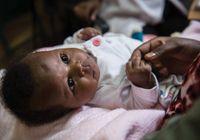
Photo credits: Jhpiego
The majority of newborns thrive with basic care and support. Newborns who are preterm, sick and/or small are more vulnerable and may require additional care at formal health services. These newborns need prompt, responsive care quickly to survive. Referral pathways should be established from the community to primary care facilities and hospitals, as well as from lower level to higher level care. A well-organized and functional referral system includes clear protocols with defining criteria and pathways for referral, trained staff, reliable transportation and a communication system (Box 5.1). In humanitarian settings, the referral system must be responsive and able to adapt to any emerging changes in the security and/or logistical status of various health facilities providing SRHabbreviation care. Systems should build on existing structures, where possible. Note that referral mechanisms are frequently designed for obstetric emergencies; additional effort may be necessary to tailor them for newborn referral. See Annex 4 for tools to assist in the referral process.
Box 5.1: The Newborn Care Referral System in a Crisis Setting: Principles
- Every newborn should have access to care with the potential for safe and timely referral if needed.
- Priority must be given to newborns exhibiting any one of the danger signs (Box 3.3 and Box 3.4) so that they receive timely care.
- Referral criteria and protocols should be established and posted at every level of care. This includes protocols specifying when and where to refer and an adequate record of referred cases (including individual names, reasons for referral, outcomes at the referral facility, return to the initial health facility, and follow-up with providers there).
- A triage system should be in place to address the most severe danger signs especially in small babies.
- Transport should be organized for referral from facilities and communities that are not easily accessed.
- A communication system with the receiving facility should be established; this is particularly important in humanitarian settings where referral may be delayed or impossible due to insecurity and road blockages.
To facilitate the implementation of an efficient, safe and effective referral and counter-referral system:
- Immediately establish relationships with local health facilities and local groups active in the region. Establishing relationships with local actors and determining referral pathways is a particular concern when a conflict or disaster has obstructed essential roadways or transport corridors.
- Use the inventory of services and the map of functional facilities developed as part of the planning process to determine which facilities are prepared to manage sick newborns, and to identify additional resources that may be needed to support referrals.
- Ensure the availability of reliable transportation, 24 hours a day, 7 days a week; ensure that fuel is available and drivers are equipped with mobile phones or radios.
- Establish or strengthen the communication system (e.g., mobile or satellite phones, radios) with the receiving facilities; ensure a designated provider is available to provide guidance at all times.
- Adapt existing registers or develop a register to track referrals and counter-referrals.
- Ensure availability of appropriate supplies and equipment to screen newborns for danger signs, including thermometers, scales, timers and job aids.
- In collaboration with partners, develop clear protocols on when, why, where and how to refer. Post protocols in facilities.
- Train staff, including CHWs, on the protocols, including how to use the communication system, how to stabilize the newborn before transfer, and how to counsel the mother on care during transport.
- Instruct CHWs to conduct follow-up on referred cases.
- Monitor and conduct audits of the referral system, including identifying any patterns in the tracking data; address bottlenecks and explore ways to improve the use and efficiency of the system
As a rule, health staff must understand that the further away the referral facility is, the earlier they must make a decision to refer newborns exhibiting danger signs (See Box 3.3 and Box 3.4).[1]
5.2.1 When referral is not feasible
Insecurity, population movements, road blockages and other challenges can delay or prevent the timely referral of vulnerable newborns. Planning for disruptions to the referral system is imperative to prevent unnecessary death and disability.
When referral is not possible:
- Train CHWs from the affected community in providing respectful and quality postnatal care, KMCabbreviation (See Box 3.2) and identifying newborn danger signs (See Box 3.3 and Box 3.4).
- Establish a functioning communication system with providers at the receiving facility to provide remote technical guidance through mobile or satellite phones, radio or online meeting platforms (e.g. Skype, Zoom etc).
- Ensure a designated provider is available 24 hours per day, 7 days a week to provide guidance.
- Train staff on the protocol for what to do when referral is not possible,info including how to use the communication system.
- Prioritize the safety and security of staff, and consider that health workers and/or certain ethnic groups may be specifically targeted for violence.
- Conduct routine audits to identify and address obstacles.
- Consider other creative ways to strengthen the referral system during insecurity and upheaval (See Box 5.2 as an example).
Box 5.2: Case study: South Sudan: developing an effective referral system in an insecure setting
In South Sudan, International Medical Corps (IMC) rolled out the Field Guide in two IDPabbreviation camps in Juba and Malakal and in one refugee camp in Maban County. IMC staff worked to strengthen the referral system for newborns, but unpredictable violence and large population movements impeded the timely referral of small and sick newborns and prevented skilled health staff from reaching health facilities.
To address these challenges, IMC developed innovative solutions to create an adaptable, resilient referral system that could cope with sudden insecurity and upheaval. IMC worked with TBAs from the community and conducted on-the-job training on Field Guide interventions, including how to identify newborn danger signs for referral and initiate KMCabbreviation for small babies before referral. Communication systems between the primary care facility and hospital were improved by training TBAs to use satellite phones so they could receive timely guidance from skilled health staff who had restricted access to facilities. This was particularly critical when referral wasn’t possible. Since many TBAs were pre-literate, pictorial referral slips were developed to ensure the receiving facility understood the cause for referral. Ethnically-motivated attacks on health workers were frequent; thus IMC specifically recruited and trained clinicians in the community from non-targeted ethnic groups to provide continuous care and supervision. Finally, staff advocated to local UNabbreviation Peacekeepers to accompany and provide protection to patients being transferred during times of insecurity. By identifying bottlenecks and developing creative, locally appropriate solutions, IMC staff were able to develop a prompt and effective referral network that helped save the lives of women and newborns.

